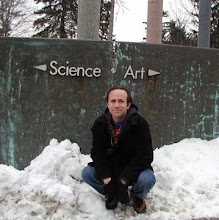First up, this page on the simultaneity of the comics page is the only page that borrows an existing composition nearly note for note, specifically a page from my journal piece "The Shape of Our Thoughts." I felt that page really hit what I wanted to hit in terms of my thinking on comics and it's been an important one in all my recent talks. Some of the text changed in order to fit within this narrative and to tie in to my more specific thoughts about how comics work. I redrew the whole thing, included different elements in the environment (including a mongoose - for all those remembering Rikki Tikki Tavi out there...), and if you really want to compare this with the original, again, you can find that in the shape of our thoughts piece. The banyan tree that the buddha figure is sitting under is something that is actually tree-like and rhizomatic - that is hierarchical and interconnected all at once, and this links back to this sequence in Ch3, and also the introduction of the term rhizome back in Ch2 here. The dialogue spoken by the buddha here is from the joke, what does the buddha order at the hot dog stand? - but I think fits neatly to talk about how all the panels, elements of a comics page constitute a whole even as they remain distinct.
This stands somewhat in opposition to the notion of comics as a sequential form, which was the subject of the previous page. I share that again here, along with the process sketches that led to its creation.
This was a difficult page to imagine - in part because this entire section is about how comics work and that meta-commentary at times leaves me wondering what to draw. Also, it's my take on Scott McCloud's theorizing, trying to boil it down to essentials that fit a narrative that while often described as being a dissertation in comics about comics, it's only partially about comics - really it's about perception and broadening the forms of meaning-making we consider to be legitimate. Anyhow, as you can maybe gather from the sketches and as I noted in the prior post, this started out something more grid-like, and then at some point i had an idea for a rube goldberg-esque/mousetrap page. But, i rejected that as pointing out the simultaneous aspects of the page when i really needed to keep the focus solely on the sequential. The big breakthrough as noted in my sketchbook came after a quick session on my trampoline and thoughts about the sequence of seasons, calendars as records of time in space, came tumbling out... I think you can get a sense of how it evolved and all came together - some of it right away and a few things I changed right up until the end.
I'm in the midst of multiple pages at once at the moment representing the finale of Ch3 and exploring the cognitive nature of comics, hoping to have more of them to share next week. Stay tuned. - Nick














